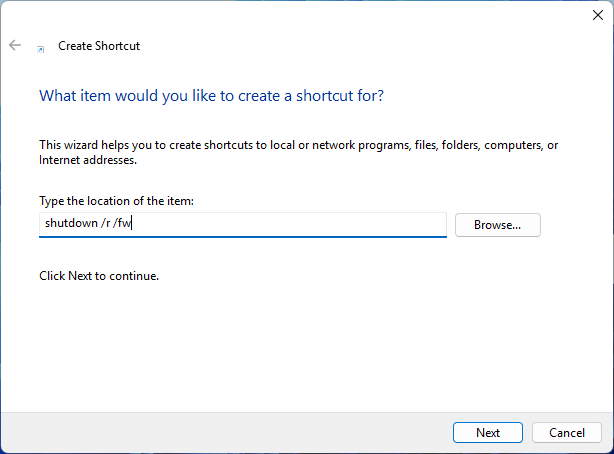Key Points
- Create a Desktop Shortcut to Boot Directly to UEFI: Use the Windows command shutdown /r /fw to reboot your Windows 10/11 device straight into UEFI/BIOS firmware settings, bypassing timing issues during POST
Step‑by‑Step Setup:
- Right‑click desktop → New > Shortcut
- Enter shutdown /r /fw as the location
- Name the shortcut (e.g. “Reboot to UEFI firmware settings”)
- Configure it to Run as administrator via Advanced Properties .
Advantages for IT Admins & Users:
- Avoids repeated attempts at hotkey entry during startup
- Simplifies remote diagnostics or firmware modifications
- Enables automation in scripts or deployment environments
Risks & Best Practices:
- Naming clarity: Use descriptive names (“Reboot to UEFI”) to reduce accidental activation
- Secure placement: Avoid placing shortcut in shared or public folders
- Policy compliance: Managed devices may enforce restrictions that disable shortcut usage
This step-by-step guide demonstrates how to create a shortcut to boot to UEFI firmware in Windows 10 and Windows 11. This removes the need for holding down keys as your PC boots. Which makes it easier to access UEFI firmware to update settings and perform troubleshooting and maintenance.
Get full control over your device’s firmware and speed up troubleshooting issues with your device.
How to access UEFI firmware settings
Accessing UEFI firmware settings usually involves pressing an assigned key. This usually includes one of the DELETE, ESCAPE, F1, F2, F10, or F12 keys/ It does this before your computer completes booting and loads the operating system. This interrupts the boot sequence and gives you access to the firmware setup interface.
Typically, the specific key you need to press is indicated with an on-screen message. For example, Press ENTER to enter setup. If this is not shown, you may need to check the device user manual, or motherboard, or find it via trial-and-error.
This process is frustrating and error-prone: the key differs between device manufacturers, and often the message telling you what key to press is only displayed briefly, if at all. The window of time for pressing the key to interrupt boot and access the UEFI firmware settings is also often less than a second. As such, it my be easy to miss and require that you wait for Windows to load, before rebooting and trying again.
A common solution to this is to hold the SHIFT key when selecting Restart from the Shutdown menu and triggering the Windows Recovery Environment (WinRE).
How to create a shortcut to boot directly to UEFI firmware settings
You can also create a desktop shortcut that reboots your device directly into the UEFI firmware settings interface. This avoids having to correctly time during the boot process, or booting to the Windows Recovery Environment.
To create a shortcut to boot directly to UEFI firmware settings, follow these steps:
- Right-click on the desktop and select New > Shortcut
- In the field labeled Type the location of the item, enter the command shutdown /r /fw
- Enter a name for the shortcut, such as “Reboot to UEFI firmware settings”
- Press Finish to complete creating the shortcut

This command does the following:
- Calls the shutdown command to shut down your Windows device
- Specifies the /r option so that your device restarts
- Specifies the /fw option telling your device to boot directly into the UEFI firmware
You will then need to configure the shortcut to run as Administrator:
- Right-click on the shortcut and select Properties
- in the Shortcut tab of the Properties dialog, click the Advanced… button
- Check the Run as administrator checkbox, and then click OK to close the advanced settings
- Click OK or Apply to save the change to the shortcut
You can change the icon for this shortcut by right-clicking on it on the desktop, selecting Properties, and then clicking on the Change Icon… button.
Using PowerShell or the Command Prompt to reboot directly to UEFI firmware settings
You can execute the command to boot directly to UEFI firmware settings from Windows directly by opening an elevated PowerShell session or the Command Prompt . Simply enter the following command:
shutdown /r /fw
Verifying and testing the UEFI shortcut
If your device supports it opening this shortcut should cause your PC to safely reboot and automatically open the UEFI settings interface. You may need to give UAC approval to allow the Windows shutdown command to run.
If it does not, check that you have correctly typed the command,. Make sure that you’ve correctly configured the shortcut to run as administrator. You should also check that your system is using UEFI instead of legacy BIOS if it is an older device.
UEFI firmware explained and why do you need to access it?
UEFI firmware is the modern replacement for the legacy BIOS that provides access to the lowest level of configuration for your PC. The UEFI firmware setup interface provides tools for configuring your PC’s:
- boot devices (including secure boot),
- device security settings,
- other hardware configurations like enabling virtualization support.
Diagnose and resolve issues quickly to keep your Windows devices running smoothly.
Troubleshooting Windows devices remotely at scale
NinjaOne provides a unified endpoint management platform that lets you centrally manage devices and support end-users in enterprise and education. You can remotely configure and monitor endpoint devices (including Windows, Apple, Android, and Linux) from a single web interface and automate the deployment of configuration changes, software updates, and security patches, including those for UEFI-based systems.








